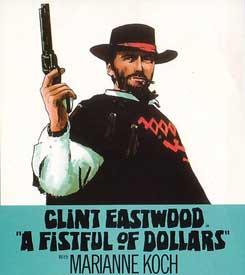 Those of us of a certain generation can never forget the revelation of Clint Eastwood starring in Sergio Leone movies, generally to be seen cast large on an outdoor screen of a drive-in theater. We'd previously known Clint as "Rowdy Yates" in the serious television drama Rawhide (1959-1966), wherein he had a boyish aspect that made him suited as the cook's assistant. Yet here was that same guy reborn bigger than life, chomping on a cheroot & murmuring threats in a soft-spoken yet growly voice, the cowboy to beat all cowboys. Those of us of a certain generation can never forget the revelation of Clint Eastwood starring in Sergio Leone movies, generally to be seen cast large on an outdoor screen of a drive-in theater. We'd previously known Clint as "Rowdy Yates" in the serious television drama Rawhide (1959-1966), wherein he had a boyish aspect that made him suited as the cook's assistant. Yet here was that same guy reborn bigger than life, chomping on a cheroot & murmuring threats in a soft-spoken yet growly voice, the cowboy to beat all cowboys.
That one of the greatest icons of the American West was presented by an Italian director did not seem ironic. Though Leone was the foremost & best known of the "spaghetti western" filmmakers, the term is a little misleading, as most spaghetti westerns do look like Mediterranean directors were trying to capture a myth they know only third or fourth hand. Leone on the other hand captured the completeness of the mythic west with an artist's eye that made it all feel ultra-realistic.
His influences were Akira Kurosawa & John Ford. Even Kurosawa had some John Ford in him, so influences come full circle in Sergio. His first film with Clint was A Fistful of Dollars (Per un pugno di dollari, 1964). The script was adapted from Kurosawa's classic Yojimbo (1961), & in emulation of the Yojimbo or Bodyguard of that film, Clint is likewise "The Man With No Name," & never mind that he gets called Joe, we can assume that moniker was default rather than actual.
The Leone "style" is slightly subdued in this first effort, & each film of the Man With No Name trilogy is visually more striking. The most overt element of his style is the use of wide scope scene-setting giving the impression of expanses, with intercut close-ups, often shot from low down to give characters a bigger-than-life perspective. Godlike figures upon eternal deserts or prairies or foothills, yet with a gruelling realism that undermines the white-hat black-hat romanticism of Hollywood westerns.
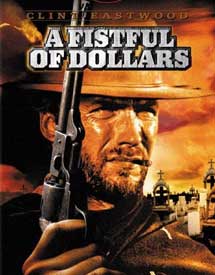 Another big part of that Leone style is in the sound & the way the music is so often keyed to specific characters, each with his own theme. Even when nothing is happening in a Leone film, the camera can linger on grizzled sunburnt faces that are exciting just blinking or staring, & the music of Ennio Morricone becomes a character in itself. Another big part of that Leone style is in the sound & the way the music is so often keyed to specific characters, each with his own theme. Even when nothing is happening in a Leone film, the camera can linger on grizzled sunburnt faces that are exciting just blinking or staring, & the music of Ennio Morricone becomes a character in itself.
The plot is pure Yojimbo. Clint Eastwood instead of Toshiro Mifune wanders into a dusty hard-bitten town in which two opposing families are at war, offering his services first to one, then to the other gang. Why he'd bother is never stated & it's one of the great mysteries of the character that he risks his life, even taking an extravagant beating, in order to clear a town of villains.
When it first aired on American television, stock footage of Eastwood & a fumbling prologue was added without any input from Eastwood or Leone, so that the character is given a "reason" for doing what he does in the rest of the film (this unnecessary prologue is included among "extras" on some dvd issues, for its novelty value). But the great thing about this character is that we don't know where he came from or why he does what he does. In samurai terms this would be strictly "wandering knight errant" stuff, a way to practice one's swordskills to the ultimate degree, or in this case skills with the gun. It's not that different from Arthurian knight lore, which is what gives us our western ideal of knight errantry.
And yet at no time is "Joe" With No Name clearly the heroic cowboy of Hollywood westerns. He has his own peculiar malevolence, which will heighten in the sequels. In Fistful of Dollars, he seems genuinely to be screwing with the minds of the rival families, but by no means intervening with their evil acts. For instance, he watches a child being traumatized without intervening. He has a bigger game in mind, instigating a mass shoot-out between the two families, whether for the pleasure of seeing their violent natures clashing, or to improve life for the few good people of the town, is never stated.
Machismo is turned into a thing of beauty from young Eastwood. With a black sense of humor he teases & tests & verbally abuses anyone or any group that stands before him hoping to menace him.
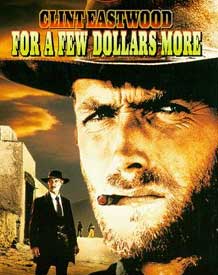 The smiling glassy-eyed psychopath in Yojimbo played by Tatsuya Nakadai is here named Ramon Rojo, played by Gian Maria Volante, though credited as Johnny Wells. He's excellent, yet the second & third films have far greater villains with enormous personalities, so that the one flaw of Fistful, if it may be regarded much of a flaw, is that it lacks a supporting cast that stands with the same enormous presence as Eastwood. The smiling glassy-eyed psychopath in Yojimbo played by Tatsuya Nakadai is here named Ramon Rojo, played by Gian Maria Volante, though credited as Johnny Wells. He's excellent, yet the second & third films have far greater villains with enormous personalities, so that the one flaw of Fistful, if it may be regarded much of a flaw, is that it lacks a supporting cast that stands with the same enormous presence as Eastwood.
For a Few Dollars More (Per qualche dollaro in piu, 1965) is one big stride forward in stylish quality, though the fact is, if Leone's films hadn't improved by leagues as he progressed as an artist, A Fistful of Dollars might well have stood alone as a great classic. Since Leone kept outdoing himself, not only Fistful but even the improved For a Few Dollars More get short-shrift from some critics who would count only The Good, the Bad, & the Ugly (1966) as a film of gigantic merit.
With better budget & fewer time restraints, Sergio Leone goes from great to greater in his second fashion-setting western. This time out the support cast is incredible, most especially Lee Van Cleef as Colonel Mortimer, as steely-visaged as Clint, who smiles more easily than Clint, but is meaner just the same.
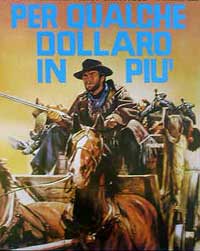 Bounty hunters in this view of the west approach being psychotic in their preference for "dead" in any "wanted dead or alive" bounty. The Man With No Name is not called Joe this time, but Manco, though he's the same guy. He's tracking Indio (Gian Maria Volonte) for the bounty, a catch that Col. Mortimer would also like to reel in, if for reasons of revenge more than for the bounty. Bounty hunters in this view of the west approach being psychotic in their preference for "dead" in any "wanted dead or alive" bounty. The Man With No Name is not called Joe this time, but Manco, though he's the same guy. He's tracking Indio (Gian Maria Volonte) for the bounty, a catch that Col. Mortimer would also like to reel in, if for reasons of revenge more than for the bounty.
By turns rivals & partners, the two "bounty killers" seek their prey but watch their own backs with each other. The Colonel is ultimately a villain more horrific in his appeal than Indio or any other villain. Standing barely within the law (if that) the Colonel will destroy anything that stands in the way of his vendetta.
Violence & ruthlessness are extreme, at the far edge of Peckinpah's bloodiest moments. It can even be argued that Peckinpah was influenced by Leone as much as vis-a-vis, since The Wild Bunch (1969) has a spaghetti western veneer & extreme violence.
Yet in between bouts & eruptions of extraordinary violence Leone provides long poetic passages of widescreen portraiture awesome in its beauty. Some scenes play out at a languid pace, like a yard-long fuse lit on a cannon, demanding the audience appreciate the environment, the soundtrack, the faces. It's not for short attention span action film fans, being a highbrow approach to lowbrow thrills.
Cruelly funny, with storytelling zest, For a Few Dollars More is one of the greatest westerns of all time, & hard to believe Leone could possibly do even better, though he would.
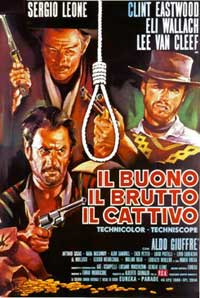 By the time Leone made The Good, the Bad, & the Ugly (Il Buono, il Brutto, il Cattivo, 1966), Clint Eastwood was a cult favorite throughout Europe. Curiously, the first two films in this trilogy had been very little seen in America. But with the third & final installment of the "Dollars" trilogy, Leone could no longer be ignored by American film distributors, & Ugly hit the action circuit & drive-ins with such phenomenal success, so the previous two films followed very shortly. By the time Leone made The Good, the Bad, & the Ugly (Il Buono, il Brutto, il Cattivo, 1966), Clint Eastwood was a cult favorite throughout Europe. Curiously, the first two films in this trilogy had been very little seen in America. But with the third & final installment of the "Dollars" trilogy, Leone could no longer be ignored by American film distributors, & Ugly hit the action circuit & drive-ins with such phenomenal success, so the previous two films followed very shortly.
Nor did they vanish quickly. They had first runs, second runs, third run triple-features, & revivals until old cinemascope prints were worn out. Then new prints were struck to be shown on college campuses & discussed in serious cinema study groups & classes. Revivals would be de rigeur in art houses.
Less happily, they were censored for excessive violence, pared down for length, & pan-&-scanned on television. That was a hideous way to see these scope features, but one way or another, everyone saw them. Leone forever changed how the ideal western would be seen, understood, & appreciated. To great extent he changed how people imagine the West to have been, & the west would never again be as clean-cut as Roy Rogers or Gene Autry.
1966/67 was the big year for Eastwood & Leone in America, & the success would drag to us from across the ocean just about every Leone imitator Italy & Spain could muster quickly, though ninety-nine percent of these others vastly more deserved the initially demeaning sobriquet "spaghetti" western.
"Spaghetti western" is now used lovingly by fans of this sub-genre, but Leone who birthed it all still belongs in a class distinct, alongside Peckinpah & Ford as the greatest cinematic western mythmakers. He did as a visionary artist what others did for commerce to cash in on a momentary craze.
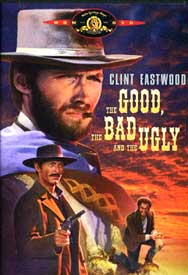 I'll never completely understand why the western faded out of American preferences. Once you could've seen six or more new western shows every week on television, & four or more feature length westerns in the cinemas every month. Today you'll get a western mini-series once in a blue moon on tv, & three or four westerns in a year, if that. I'll never completely understand why the western faded out of American preferences. Once you could've seen six or more new western shows every week on television, & four or more feature length westerns in the cinemas every month. Today you'll get a western mini-series once in a blue moon on tv, & three or four westerns in a year, if that.
Leone's masterworks momentarily revived the great artform that the Western is capable of being. And following this last great flourishing, the occasional flair-ups of interest would continue to be led by such practioners as Clint Eastwood himself, who learned his best licks from Leone. Sergio's influence was international, & Japanese film fans will detect in 1970s samurai films a tendency to provide some of them with scores reminiscent of Ennio Morricone's music for Leone films.
In some ways the second of the trilogy is the best film. The addition of a second "foil" for Eastwood in Ugly in the person of Eli Wallach is a decided bonus that puts it foremost in many people's minds, yet For a Few Dollars More has two truly elemental performances from Eastwood & Van Cleef that neither of them quite duplicated in years to follow, unless Eastwood did so in High Plains Drifter. These two bounty hunters are Olympian anti-heroes, if Olympus were in Hell, & the "bad" men played expansively by such as Gian Maria Volonte & Klaus Kinski, are big enough to be worthy targets for the lightning bolts of the gods.
Eastwood as Blondie in Ugly has turned in Mexican bandito Tuco (Eli Wallach) for the bounty, then hid some distance away to shoot the rope before Tuco could hang. Making his getaway on the horse the sheriff had set him astride, Tuco is soon re-captured by the bounty hunter who turns him in at the next town for the same bounty, & once more shoots the rope.
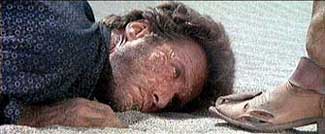 Tuco was pretty peevish about this unwanted partnership even before Blondie took two rather than one shot to sever a rope, & had him dangling for a bit. When he gets the drop on his captor, he herds him on a forced walk across the desert until Blondie's near death from dehydration & his face one gigantic blister. Tuco was pretty peevish about this unwanted partnership even before Blondie took two rather than one shot to sever a rope, & had him dangling for a bit. When he gets the drop on his captor, he herds him on a forced walk across the desert until Blondie's near death from dehydration & his face one gigantic blister.
Blondie is "the good" not only because he's best looking but because he wouldn't intentionally kill anyone who didn't try to kill him first or deserve it awfully. His speechless concern for a dying Civil War soldier is just one scene in passing that shows his humanity, despite that as a gunman he can be more than a little dangerous.
"The ugly" is Tuco, because he is unattractive & not the least honorable, though it can be said that his disposition only gets peevish with good cause, & he's not otherwise void of a sense of humor.
"The bad" is the tall gaunt Angel Eyes (Lee Van Cleef), a vicious hitman apt to abuse even the helpless & the innocent just because he can.
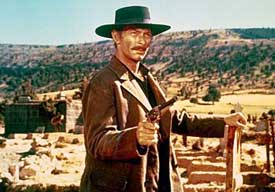 All three have learned one-third of a secret that can lead them to a cache of gold buried in a graveyard. They'll never trust one another, but they must each keep the other two alive until the gold can be found. All three have learned one-third of a secret that can lead them to a cache of gold buried in a graveyard. They'll never trust one another, but they must each keep the other two alive until the gold can be found.
The weavings of plot & the doings of these three characters make for a genuine epic western. Some will find the lack of historicity more than commonly annoying. Few westerns are accurate as to history, but this may be the only one to assume the American Civil War occurred in the southwest.
The home-made inaccuracies of American westerns are likewise legion, with the persistent misrepresentation of Native Americans especially egregious. So I am not overly troubled to believe the fantasy that the Confederacy made inroads into the southwest, since for my suspension of disbelief, I get a walloping good story.
The triadic shoot-out at the end is a quarter hour that by its intensity barely lets a viewer take a breath. Then the startling last minute of the film, & that last half-second which shouts a paeon to Morricone, ah, it's all simply too beautiful. Morricone's soundtrack album was a top seller, & truly holds up on its own apart from the movie, splendid moody sorrowful & dramatic music.
And the scope cinematography of Tonino Delli Colli makes long wide shots of countrysides & close-ups of grizzled faces appear frame by frame to be classic illustration. The film can be viewed again & again with viewer attention on some other great aspect of a great film.
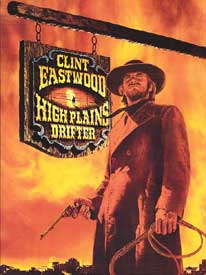 Some fans believe they have detected the Man With No Name was in fact named Joseph Manco, because he's called Joe in Fistful of Dollars & Manco in For a Few Dollars More. Some fans believe they have detected the Man With No Name was in fact named Joseph Manco, because he's called Joe in Fistful of Dollars & Manco in For a Few Dollars More.
But "Joe" is what you'd call someone who refuses to give you his name, like Jack or Pal or Buddy. "Manco" is not a name but possibly an insult, meaning "idiot," "one-armed cripple" or "stupido," but not necessarily fighting words since it can simultaneously mean "monastic" or "solitary," i.e., a loner. It can also refer to a man as having only one hand, & the man who once calls him Manco has observed Eastwood's character dealing cards & lighting his cigar without removing his other hand from his gun. Then again, in The Good, the Bad, & the Ugly, he's merely Blondie, hardly an actual name.
He's again the Man With No Name in Eastwood's personal homage to Sergio Leone, High Plains Drifter (1973). This film may in fact name the character at the end.
Though often tagged as a American-made spaghetti western because of star/director Clint Eastwood's influences from Sergio Leone (watch for Sergio's name on a gravestone), Clint adds an original stamp of mysticism to his take on the genre, creating something of a magic realist western. The possibility that the Stranger is a ghost is never definitively certain, but there's a horror story tone here & there, & a very eerie soundtrack, indicating a justifiably malevolent tale.
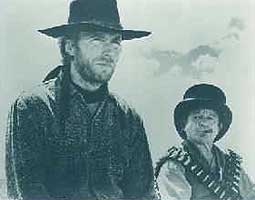 "The Stranger" or Man With No Name is not merely bigger than life, but quite possibly an avenging angel, Death himself, if not merely the ghost of someone killed in Lago returning from the grave for his pound of flesh, riding straight into town not from the high plains but from that little grave outside of town, on unhallowed ground. "The Stranger" or Man With No Name is not merely bigger than life, but quite possibly an avenging angel, Death himself, if not merely the ghost of someone killed in Lago returning from the grave for his pound of flesh, riding straight into town not from the high plains but from that little grave outside of town, on unhallowed ground.
By film's end, when the Stranger rides out of the renamed town, the grave he rides across we at last know is that of Marshal Jim Duncan. This may have been the name of the Stranger himself.
What is certain is that the Stranger has some connection to that sheriff betrayed by the lakeside town of Lago. The denizens of Lago shamefully keep their collective deed a closely guarded secret. Yet the Stranger somehow knows everything that happened, as visions, memories, & nightmares. Unbeknownst to these people, the Stranger intends to turn the mean little mining town into a genuine place in Hell, literally renamed so & painted red.
When he first drifts into town, he finds these long-term cowards beset by outlaws who have the townspeople wetting themselves with fright. When they attempt to bully the Stranger, things go quite badly for them. The townfolk thus hire the Stranger as protection, with clear influence of Akira Kurosawa, the same influence by which Leone launched the western revival.
The Stranger is the anti-hero extraordinaire, not merely a good guy with roguish traits. In the name of revenge he'll even be a rapist. Further evidence of his ghostly or elemental nature comes when his rape victim tries to shoot him in his bath. Bullets have no effect on him. A viewer can assume the girl was a bad shot even at near point blank range, but it seems more likely he's something Other.
Bad as he is, we stay on his side because first of all it's Clint & second of all everyone else is so scoundrelly & snivelling they deserve even worse than they get. But he certainly takes the nature of the anti-hero to new lows of cruelty. And despite the horror & depravity, some of it is surprisingly comical, in a droll manner.
This is my favorite film directed by Clint, & it's one of the greatest westerns of all time. It's not devoid of sentiment but it is a hardbitten cynical tale with only Mordecai the midget (Billy Curtis) coming off at all well.
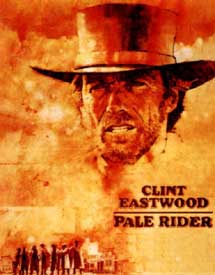 Clint's final outing as the Man With No Name is Pale Rider (1985), this time identified only as "Preacher." If he is the same elemental as in High Plains Drifter, then he is definitely an avenging angel, not Marshal Duncan's ghost specifically. Rather than beaten to death like Duncan, the Pale Rider was killed by a completely different method, multiple gunshots at close range in the back, even through the heart. Clint's final outing as the Man With No Name is Pale Rider (1985), this time identified only as "Preacher." If he is the same elemental as in High Plains Drifter, then he is definitely an avenging angel, not Marshal Duncan's ghost specifically. Rather than beaten to death like Duncan, the Pale Rider was killed by a completely different method, multiple gunshots at close range in the back, even through the heart.
Again, as magic realism instead of outright fantasy, it can be interpreted either way, but when we finally see the scars of how many bullets he recovered from, there seems awfully slim chance that he recovered by any natural means; & Eastwood himself as asserted that this time there's no question at all but that the gunslinger is a ghost.
When the tagline tells us "Death rides a pale horse," it's being pretty strongly telegraphed that this holy gunfighter is one of the four horsemen of the apocalypse. It has even been suggested that this is an unofficial sequel to the classic Shane (1953), the hero of which having ridden into the sunset at the end, motionless in his saddle because bullet-ridden & dead.
It's not the equal of High Plains Drifter, but it's good. The mining colony looks like a movie set, & not a very elaborate one, & there's a lot of just ridin' along the countryside to avoid having to spend any money on anything that looks like the old west. So it shows some budget limitations that weren't evident with High Plains Drifter.
When a young girl's pet is killed, she (Sydney Penny) prays for vengeance, & soonafter a preacher on horseback appears out of the shimmering heat of the horizon. He begins almost immediately to cause massive grief to all the bad guys in defense of the lowliest miners & their families, who include the girl who prayed, her mother (Carrie Snodgrass), & her mother's fiance (Michael Moriarity).
At a nearby town the Pale Rider reclaims from a bankbox an unusual gun with extremely long muzzle that comes apart in pieces. He puts his preacher's collar in the long gun's place.
He may seem to be a selfless protector of the oppressed, but there's an element of personal vengeance, too, for he is eventually recognized by the corrupt Marshal Stockburn (John Russell) as a man Stockburn personally killed some while earlier while using his badge as a license to kill for whoever it pleased or profited him to kill.
The story takes the expected route with good defended & evil either slain or transformed. The Man With No Name rides back into the heat-wave horizon, it wouldn't've been surprising to see him show up one more time in yet another film. But he never did. This was the last outing for Clint's signature character, perhaps because Clint himself felt it had mainly ended with the extraordinary High Plains Drifter being lent a name. He did have one more great western in him, however, Unforgiven (1992), & it's not too late he might yet do it again.
copyright © by Paghat the Ratgirl
|
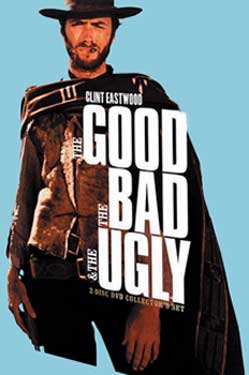

 Another big part of that Leone style is in the sound & the way the music is so often keyed to specific characters, each with his own theme. Even when nothing is happening in a Leone film, the camera can linger on grizzled sunburnt faces that are exciting just blinking or staring, & the music of Ennio Morricone becomes a character in itself.
Another big part of that Leone style is in the sound & the way the music is so often keyed to specific characters, each with his own theme. Even when nothing is happening in a Leone film, the camera can linger on grizzled sunburnt faces that are exciting just blinking or staring, & the music of Ennio Morricone becomes a character in itself. The smiling glassy-eyed psychopath in Yojimbo played by Tatsuya Nakadai is here named Ramon Rojo, played by Gian Maria Volante, though credited as Johnny Wells. He's excellent, yet the second & third films have far greater villains with enormous personalities, so that the one flaw of Fistful, if it may be regarded much of a flaw, is that it lacks a supporting cast that stands with the same enormous presence as Eastwood.
The smiling glassy-eyed psychopath in Yojimbo played by Tatsuya Nakadai is here named Ramon Rojo, played by Gian Maria Volante, though credited as Johnny Wells. He's excellent, yet the second & third films have far greater villains with enormous personalities, so that the one flaw of Fistful, if it may be regarded much of a flaw, is that it lacks a supporting cast that stands with the same enormous presence as Eastwood. Bounty hunters in this view of the west approach being psychotic in their preference for "dead" in any "wanted dead or alive" bounty. The Man With No Name is not called Joe this time, but Manco, though he's the same guy. He's tracking Indio (Gian Maria Volonte) for the bounty, a catch that Col. Mortimer would also like to reel in, if for reasons of revenge more than for the bounty.
Bounty hunters in this view of the west approach being psychotic in their preference for "dead" in any "wanted dead or alive" bounty. The Man With No Name is not called Joe this time, but Manco, though he's the same guy. He's tracking Indio (Gian Maria Volonte) for the bounty, a catch that Col. Mortimer would also like to reel in, if for reasons of revenge more than for the bounty.
 I'll never completely understand why the western faded out of American preferences. Once you could've seen six or more new western shows every week on television, & four or more feature length westerns in the cinemas every month. Today you'll get a western mini-series once in a blue moon on tv, & three or four westerns in a year, if that.
I'll never completely understand why the western faded out of American preferences. Once you could've seen six or more new western shows every week on television, & four or more feature length westerns in the cinemas every month. Today you'll get a western mini-series once in a blue moon on tv, & three or four westerns in a year, if that. Tuco was pretty peevish about this unwanted partnership even before Blondie took two rather than one shot to sever a rope, & had him dangling for a bit. When he gets the drop on his captor, he herds him on a forced walk across the desert until Blondie's near death from dehydration & his face one gigantic blister.
Tuco was pretty peevish about this unwanted partnership even before Blondie took two rather than one shot to sever a rope, & had him dangling for a bit. When he gets the drop on his captor, he herds him on a forced walk across the desert until Blondie's near death from dehydration & his face one gigantic blister. All three have learned one-third of a secret that can lead them to a cache of gold buried in a graveyard. They'll never trust one another, but they must each keep the other two alive until the gold can be found.
All three have learned one-third of a secret that can lead them to a cache of gold buried in a graveyard. They'll never trust one another, but they must each keep the other two alive until the gold can be found.
 "The Stranger" or Man With No Name is not merely bigger than life, but quite possibly an avenging angel, Death himself, if not merely the ghost of someone killed in Lago returning from the grave for his pound of flesh, riding straight into town not from the high plains but from that little grave outside of town, on unhallowed ground.
"The Stranger" or Man With No Name is not merely bigger than life, but quite possibly an avenging angel, Death himself, if not merely the ghost of someone killed in Lago returning from the grave for his pound of flesh, riding straight into town not from the high plains but from that little grave outside of town, on unhallowed ground.